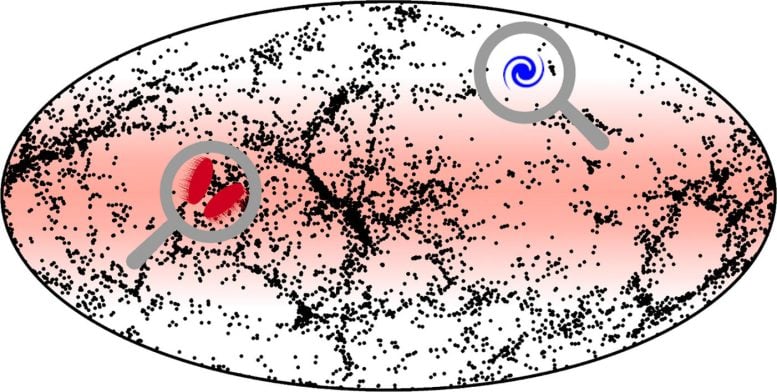
Why is the immense supergalactic plane predominantly filled with a single type of galaxy? This longstanding astronomical mystery may finally be solved.
The Milky Way galaxy, our cosmic home, is nestled within a vast expanse known as the local Supercluster. This colossal structure encompasses numerous hefty galaxy clusters and a multitude of individual galaxies. Characterized by its pancake-like configuration, the Supercluster spans nearly a billion light-years in width, earning it the moniker of the Supergalactic Plane.
Most galaxies in the universe fall into one of two categories: firstly, elliptical galaxies, made mostly of old stars and containing typically extremely massive central black holes, and secondly actively star-forming disk galaxies, with a spiral-like structure similar to the Milky Way’s. Both types of galaxies are also found in the Local Supercluster, but while the Supergalactic Plane is teeming with bright ellipticals, bright disk galaxies are conspicuously absent.
A cosmic anomaly challenges the standard model of cosmology
This peculiar segregation of galaxies in the Local Universe, which has been known since the 1960s, features prominently in a recent list of “cosmic anomalies” compiled by renowned cosmologist and 2019 Nobel laureate Jim Peebles.
Now an international team led by University of Helsinki astrophysicists Till Sawala and Peter Johansson appear to have found an explanation. In an article published in Nature Astronomy, they show how the different distributions of elliptical and disk galaxies arise naturally due to the different environments found inside and outside of the Supergalactic Plane.

“In the dense galaxy clusters that are found on the Supergalactic Plane, galaxies experience frequent interactions and mergers, which leads to the formation of ellipticals and the growth of supermassive black holes. By contrast, away from the plane, galaxies can evolve in relative isolation, which helps them preserve their spiral structure,” says Till Sawala.
In their work, the team made use of the SIBELIUS (Simulations Beyond The Local Universe) simulation, that follows the evolution of the universe over 13.8 billion years, from the early universe to the present. It was run on supercomputers in England and on CSC’s Mahti supercomputer in Finland.
Implications and Future Directions in Cosmology
While most similar simulations consider random patches of the universe which cannot be directly compared to observations, the SIBELIUS simulation aims to precisely reproduce the observed structures, including the Local Supercluster. The final simulation result is remarkably consistent with the observations.
“By chance, I was invited to a symposium in honor of Jim Peebles last December, where he presented the problem in his lecture. And I realized that we had already completed a simulation that might contain the answer,” comments Till Sawala. “Our research shows that the known mechanisms of galaxy evolution also work in this unique cosmic environment.”
Next to the physics department, the University of Helsinki’s Kumpula campus hosts a large statue showing the distribution of galaxies in the Local Supercluster. It was inaugurated 20 years ago by the British cosmologist Carlos Frenk, who is one of the co-authors of this new study. “The distribution of galaxies in the Local Supercluster is indeed remarkable,” says Frenk of the new results. “But it is not an anomaly: our result shows that our standard model of dark matter can produce the most remarkable structures in the universe.”
Reference: “Distinct distributions of elliptical and disk galaxies across the Local Supercluster as a ΛCDM prediction” by Till Sawala, Carlos Frenk, Jens Jasche, Peter H. Johansson and Guilhem Lavaux, 20 November 2023, Nature Astronomy.
DOI: 10.1038/s41550-023-02130-6
6 Comments
Ah, problem solved. Cup of tea ?
“The distribution of galaxies in the Local Supercluster is indeed remarkable,” says Frenk of the new results. “But it is not an anomaly: our result shows that our standard model of dark matter can produce the most remarkable structures in the universe.”
Rees has been talking out of his posterior in that way for decades.
No one speaks the in posterior tense better than Frenk, though.
When gravity is correctly quantized, the reason for sheets and filaments is shown to relate to concentrations in gravitational flow creating bindings in extended structures at the galactic cluster scale. Gravity flow has to pick directions and what better place to outflow is there but in the general direction of inflows? And what if return fire aim improves as matter cools, especially along emerging spin axes of cooling hydrogen ions and the like?
What DM can’t do is reproduce galaxy evolution creating long-lived spiral structures. Better BH models with polar jets and peripheral cooling seemingly would help, there. One problem might be that something easily overlookable has to organize such BH spins together coherently.
In my way of looking at it, a way to condense matter around a single compact dominant spinning mass into a forming disruptible *galaxy-sized ring* capable of being stretched into splitting into a pair of arms, or eventually capable of compressing upon the core to deform it into a rising column collapsing into a bar is what is needed. Better yet would be an excuse to build concentric layers of rings. Oh wait! All it takes is conserving super-minute amounts of radiatable massless quantum gravitational angular momentum! How boring that must be to the Einsteinian book-income-enriched simulationist!
This story has been bouncing around for weeks. Simulationists see things in their simulations no one else necessarily can. It’s the power of love. See, Einstein’s religion, lots of dark matter, and thee, is all ewe ever need.
Good study,
& Literature
Physicists are starting to think early galaxies are cigar-shaped. Most likely explanation is that gravitational lensing distortions are distorting those early galaxies.
As noted previously, allowing radiated vector-field gravity quanta that carry a quantum angular moment with a galactic-scale wave-cycle has the effect of embedding a concentric ripple effect in gravitational distortions. Galactic images are focused best along the wave peaks in the ripples. The ripples are quantum gravity effects radiated from a dense galactic core, but are being treated as ripples in “dark matter” living up to its role as a “misplaceholder” to help out MONDians and other Blinestein fanatics.